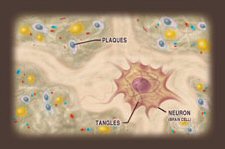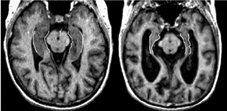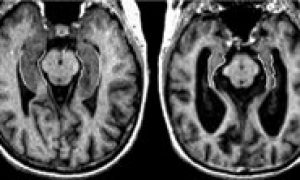Alzheimer’s disease is a progressive, degenerative brain disease. Several changes occur in the brains of people with Alzheimer’s disease. The brain cells shrink or disappear, and are replaced by dense, irregularly-shaped spots, or plaques. Another indicator of the disease is thread-like tangles within existing brain cells. These tangles eventually choke healthy brain cells.

As the image below shows, a person with Alzheimer’s disease has less brain tissue (right) than a person who does not have the disease (left). This shrinkage will continue over time, affecting how the brain functions.

MRI images courtesy of Sunnybrook and
Women’s College Health Sciences Centre
As Alzheimer’s disease affects each area of the brain, certain functions or abilities are lost. This results in specific symptoms or changes in behaviour. Once an ability is lost, it can rarely be relearned.
Although the disease results in changes, it does not affect the person’s ability to appreciate, respond to and experience feelings such as joy, anger, fear, love or sadness.
While it is not possible to restore function to brain cells damaged by Alzheimer’s disease, there are treatments and strategies that can help both the person with the disease and the caregiver.
Forms of Alzheimer’s Disease
Sporadic Alzheimer’s disease is the more common form of the disease and accounts for 90 to 95 per cent of all cases. The role of heredity in this form is unclear and is the subject of much research.
Familial Autosomal Dominant Alzheimer’s disease is a less common form of the disease and accounts for 5 to 10 per cent of known cases. In certain families, this form is passed directly from one generation to another.
Click here for an interactive tour of the brain!
Further Information:
object(Timber\Post)#1988 (44) {
["ImageClass"]=>
string(12) "Timber\Image"
["PostClass"]=>
string(11) "Timber\Post"
["TermClass"]=>
string(11) "Timber\Term"
["object_type"]=>
string(4) "post"
["custom"]=>
array(3) {
["_wp_page_template"]=>
string(18) "page-parentbox.php"
["pg_extra_pageboxes"]=>
string(15) "Other Dementias"
["_thumbnail_id"]=>
string(3) "336"
}
["___content":protected]=>
string(3539) "
Alzheimer’s disease is a progressive, degenerative brain disease. Several changes occur in the brains of people with Alzheimer’s disease. The brain cells shrink or disappear, and are replaced by dense, irregularly-shaped spots, or plaques. Another indicator of the disease is thread-like tangles within existing brain cells. These tangles eventually choke healthy brain cells.

As the image below shows, a person with Alzheimer’s disease has less brain tissue (right) than a person who does not have the disease (left). This shrinkage will continue over time, affecting how the brain functions.

MRI images courtesy of Sunnybrook and
Women’s College Health Sciences Centre
As Alzheimer’s disease affects each area of the brain, certain functions or abilities are lost. This results in specific symptoms or changes in behaviour. Once an ability is lost, it can rarely be relearned.
Although the disease results in changes, it does not affect the person’s ability to appreciate, respond to and experience feelings such as joy, anger, fear, love or sadness.
While it is not possible to restore function to brain cells damaged by Alzheimer’s disease, there are treatments and strategies that can help both the person with the disease and the caregiver.
Forms of Alzheimer’s Disease
Sporadic Alzheimer’s disease is the more common form of the disease and accounts for 90 to 95 per cent of all cases. The role of heredity in this form is unclear and is the subject of much research.
Familial Autosomal Dominant Alzheimer’s disease is a less common form of the disease and accounts for 5 to 10 per cent of known cases. In certain families, this form is passed directly from one generation to another.
Click here for an interactive tour of the brain!
Further Information:
"
["_permalink":protected]=>
NULL
["_next":protected]=>
array(0) {
}
["_prev":protected]=>
array(0) {
}
["_css_class":protected]=>
NULL
["id"]=>
int(90)
["ID"]=>
int(90)
["post_author"]=>
string(1) "1"
["post_content"]=>
string(3246) "Alzheimer's disease is a progressive, degenerative brain disease. Several changes occur in the brains of people with Alzheimer's disease. The brain cells shrink or disappear, and are replaced by dense, irregularly-shaped spots, or plaques. Another indicator of the disease is thread-like tangles within existing brain cells. These tangles eventually choke healthy brain cells.

As the image below shows, a person with Alzheimer's disease has less brain tissue (right) than a person who does not have the disease (left). This shrinkage will continue over time, affecting how the brain functions. [caption id="attachment_335" align="aligncenter" width="227"]

MRI images courtesy of Sunnybrook and
Women's College Health Sciences Centre[/caption] As Alzheimer's disease affects each area of the brain, certain functions or abilities are lost. This results in specific symptoms or changes in behaviour. Once an ability is lost, it can rarely be relearned. Although the disease results in changes, it does not affect the person's ability to appreciate, respond to and experience feelings such as joy, anger, fear, love or sadness. While it is not possible to restore function to brain cells damaged by Alzheimer's disease, there are treatments and strategies that can help both the person with the disease and the caregiver.
Forms of Alzheimer's Disease
Sporadic Alzheimer's disease is the more common form of the disease and accounts for 90 to 95 per cent of all cases. The role of heredity in this form is unclear and is the subject of much research. Familial Autosomal Dominant Alzheimer's disease is a less common form of the disease and accounts for 5 to 10 per cent of known cases. In certain families, this form is passed directly from one generation to another.
Click here for an interactive tour of the brain! Further Information:
"
["post_date"]=>
string(19) "2013-09-24 18:28:34"
["post_excerpt"]=>
string(116) "Alzheimer's disease is a form of dementia. This progressive, degenerative brain disease causes changes in the brain."
["post_parent"]=>
int(10038)
["post_status"]=>
string(7) "publish"
["post_title"]=>
string(24) "Alzheimer's Disease"
["post_type"]=>
string(4) "page"
["slug"]=>
string(18) "alzheimers-disease"
["__type":protected]=>
NULL
["_wp_page_template"]=>
string(18) "page-parentbox.php"
["pg_extra_pageboxes"]=>
string(15) "Other Dementias"
["_thumbnail_id"]=>
string(3) "336"
["post_date_gmt"]=>
string(19) "2013-09-24 18:28:34"
["comment_status"]=>
string(6) "closed"
["ping_status"]=>
string(6) "closed"
["post_password"]=>
string(0) ""
["post_name"]=>
string(18) "alzheimers-disease"
["to_ping"]=>
string(0) ""
["pinged"]=>
string(0) ""
["post_modified"]=>
string(19) "2013-09-24 18:28:34"
["post_modified_gmt"]=>
string(19) "2013-09-24 18:28:34"
["post_content_filtered"]=>
string(0) ""
["guid"]=>
string(48) "http://dev.digitalrelay.ca/alzheimer/?page_id=90"
["menu_order"]=>
int(1)
["post_mime_type"]=>
string(0) ""
["comment_count"]=>
string(1) "0"
["filter"]=>
string(3) "raw"
["meta_fields"]=>
array(0) {
}
["status"]=>
string(7) "publish"
["extra_pageboxes"]=>
array(0) {
}
["pg_hide_pageboxes"]=>
bool(false)
}
bool(true)



